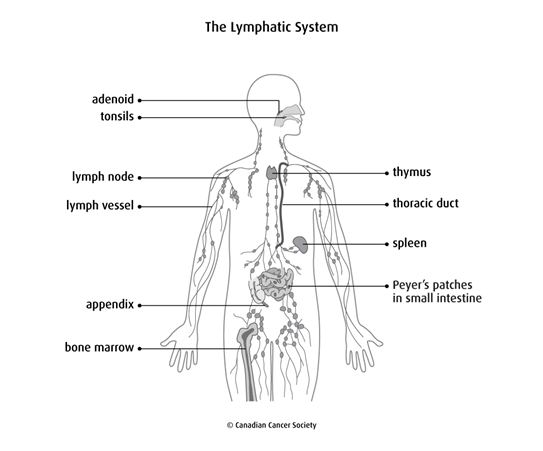The lymphatic system
The lymphatic system is a circulatory system made up of lymph vessels, which are
much like blood vessels. It drains extra fluid (called lymph) that has passed out of
the blood and into tissues and returns it back to the blood. The lymphatic system
also includes tissues and organs that make, store and release lymphocytes (a type of
The lymphatic system includes the tonsils, spleen, thymus, lymph nodes and lymph
vessels and is an important part of the
immune system
that helps defend the body against disease. It also helps maintain blood pressure
and transports some

Lymph
Lymph is a clear fluid that contains lymphocytes, a type of white blood cell
that fights germs, foreign substances and abnormal cells, like cancer cells.
Lymph also has
Lymphocytes
Lymphocytes fight disease and micro-organisms that cause infections, like bacteria, viruses, fungi and parasites. They are important cells in the body’s immune system. There are 3 types of lymphocytes:
- B cells( B lymphocytes) make antibodies to fight an infection.
- T cells( T lymphocytes) defend the body against disease and infection and control the immune response.
- Natural killer cells attack cells infected with a virus and abnormal cells, like cancer cells.
Lymph vessels
Lymph vessels are tubes that carry lymph through the body to lymph nodes and back to veins. The network of lymph vessels is similar to blood vessels (arteries and veins) that carry blood. Lymph vessels carry waste products, germs and damaged cells away from the body’s tissues.
Lymph nodes
Lymph nodes are small, bean-shaped masses of lymphatic tissue along lymph vessels. They store lymphocytes and filter waste, bacteria and damaged cells (including cancer cells) from lymph. The lymphocytes inside the lymph nodes also attack bacteria and viruses that they find in the lymph. This is why lymph nodes often get swollen when we are sick or fighting off an illness like a cold or the flu.
Lymph nodes are found in many parts of the body. The number of lymph nodes varies from one part of the body to another. Lymph nodes are located in groups, mainly in the:
- neck (called cervical lymph nodes)
- chest (called thoracic and mediastinal lymph nodes)
- armpit (called axillary nodes)
- abdomen (called para-aortic, peri-aortic and mesenteric lymph nodes)
- groin (called inguinal lymph nodes)
Tonsils
Tonsils are small masses of tissue at the back of the mouth and nose and at the top of the throat. Tonsils have many lymphocytes.
The adenoid (pharyngeal tonsil) is a single, small mass of lymphatic tissue in the back of the nose that contains lymphocytes. The adenoid is largest in children and starts to shrink just before puberty. Although it is often called “the adenoids,” there is only one adenoid.
The tonsils and adenoid help the body fight infection and protect the opening to the digestive system and lungs from bacteria and viruses.
Spleen
The spleen is an organ in the
Thymus
The thymus is a gland in the middle of the chest behind the sternum (breastbone)
that sits in an area of the chest called the
Lymphatic tissue
The lymphatic system also includes areas of the body that have high numbers of lymphocytes. These areas are called lymphatic tissue. They include the appendix and areas of the small intestine called Peyer’s patches. There are also areas of lymphatic tissue scattered in other parts of the digestive system and respiratory system. Like lymph nodes, lymphatic tissue helps remove waste, bacteria and damaged cells from lymph.
Bone marrow
The bone marrow is where lymphocytes and other blood cells are made. The bone marrow is the soft, spongy area inside of most bones. Many of the blood cells in the bone marrow are immature and are called stem cells. Stem cells change and grow into different types of cells, including blood cells. Most blood cells grow and mature in the bone marrow. Most blood cells leave the bone marrow and move into the blood and other areas of the body once they are mature.
Your trusted source for accurate cancer information
With support from readers like you, we can continue to provide the highest quality cancer information for over 100 types of cancer.
We’re here to ensure easy access to accurate cancer information for you and the millions of people who visit this website every year. But we can’t do it alone.
Every donation helps fund reliable cancer information, compassionate support services and the most promising research. Please give today because every contribution counts. Thank you.
